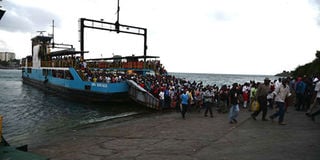Sh46bn Likoni bridge to uproot 3,000 people

Passengers disembark from MV Kwale Ferry at Likoni channel in Mombasa on January 17, 2019. PHOTO | FILE | NATION MEDIA GROUP
What you need to know:
The Likoni bridge is expected to be the solution to the constant challenges facing residents and motorists commuting between the South Coast and Mombasa mainland.
Currently, residents depend on ferries and the government hopes that the 1.5 kilometres long and 69 metres cable-supported bridge will improve connectivity to Mombasa island.
The government is set to spend some Sh9.5 billion to resettle the affected people and compensate building owners.
Thousands of Mombasa residents are set to be affected as the government moves in to demolish buildings to pave the way for the erection of the Sh46 billion Likoni bridge.
This comes just days after Japan and Kenya signed a Sh88 billion deal for the construction of the 1.5-kilometre Mombasa Gate Bridge and the Dongo Kundu Special Economic Zone.
The project is now expected to begin in 2021 and is fully funded by the Japanese government through a loan and grant.
1,200 HOUSES
The Likoni bridge is expected to be the solution to the constant challenges facing residents and motorists commuting between the South Coast and Mombasa mainland.
Currently, residents depend on ferries and the government hopes that the 1.5 kilometres long and 69 metres cable-supported bridge will improve connectivity to Mombasa island.
According to the project documents seen by the Nation, more than 3,000 people will be displaced and over 2,000 buildings demolished to clear the way for the project.
The government is set to spend some Sh9.5 billion to resettle the affected people and compensate building owners.
The demolition will involve residential and commercial buildings on both Mombasa Island and Likoni South mainland. The bridge is expected to start at Lumumba road in Majengo and end on Moi Avenue along Archbishop Makarios Road.
At least 1,201 residential houses and 833 commercial buildings would be affected.
Seven public schools, four churches, three cemeteries and four shrines will also be affected, according to the project feasibility study report.
725 PLOTS
The 3,230 residents, who are occupying the affected areas, would be displaced.
The structures are located along Lumumba Road, Mwakiringo Street, Machakos Road, Moi Avenue, Archbishop Makarios Road and Mnazi Mmoja Street in Mombasa Island.
Those in Likoni side include Jamvi la Wageni, Old Mtongwe Road and the new Mtongwe Road.
The report says the bridge will traverse 725 plots in the county.
The affected parcels of land include 125 commercial and 10 residential plots in Majengo area, 234 residential and 38 commercial plots in Likoni and 46 residential plots in Mtongwe.
Others are 263 parcels in Shika Adabu including commercial, residential and agricultural lands and nine agricultural plots in Ng’ombeni, Kwale county.
REVALIDATE
Likoni sub-county will account for 82.5 per cent of land to be acquired for the project.
Meanwhile, the report says that Sh9.5 billion will go to land compensation including structures and commercial business enterprises.
“A final survey for vesting of the acquired land to the national or county governments will have to be done by the acquiring authority.
“The commission (National Land Commission) can assist in this exercise at costs borne by the acquiring body,” the report reads in part.
A source told the Nation that the government will revalidate the report in January.
SEZ PROJECT
Last Friday, the government signed an agreement with Japan that saw Kenya receive Sh88 billion for the construction of the bridge, the development of the Dongo Kundu Special Economic Zone (SEZ) project and other infrastructure developments in Mombasa.
Acting Treasury CS Ukur Yattani said Sh46 billion will be used for building the Likoni Bridge, known as the Mombasa Gate Bridge.
Mr Yattani said the other financial development assistance amounting to Sh36 billion will be spent in the SEZ project.
The CS said the remaining Sh6 billion will be used in the Phase I of the SEZ project in the building of infrastructural development, which will include the provision of water supply to the proposed construction of the first Berth at Dongo Kundu, land levelling and drainage works.




